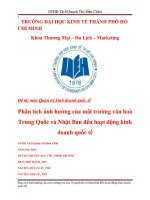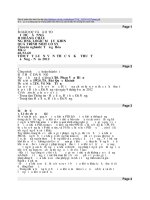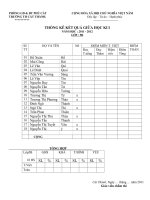UBI-GM-Presentation15.050112-place pps
Bạn đang xem bản rút gọn của tài liệu. Xem và tải ngay bản đầy đủ của tài liệu tại đây (1.97 MB, 29 trang )
Exporting and Logistics: Special Issues for Business
Exporting and Logistics: Special Issues for Business
Chapter 15
McGraw-Hill/Irwin © 2005 The McGraw-Hill Companies, Inc. All rights reserved.
PowerPoint presentation prepared by:
Alfred Lowey-Ball
Associate Professor of Marketing
UBI-United Business Institutes
Brussels, Belgium
Chapter Outline
•
Austin Inc.: Export of a paper converting machine
•
Export restrictions
•
Determining export requirements—licenses
•
Electronic support for export licensing
•
Import restrictions
•
Tariffs Standards
•
Exchange permits Boycotts
•
Quotas Voluntary restrictions
•
Import licenses Other restrictions
•
Terms of Sale
•
Foreign commercial payments
•
Letters of credit Open accounts
•
Bills of exchange Forfeiting
•
Cash in advance
•
Export Documents
•
Packing and marking
•
Customs-privileged zones
•
Logistics
•
Austin Inc.: Export of a paper converting machine
•
Export restrictions
•
Determining export requirements—licenses
•
Electronic support for export licensing
•
Import restrictions
•
Tariffs Standards
•
Exchange permits Boycotts
•
Quotas Voluntary restrictions
•
Import licenses Other restrictions
•
Terms of Sale
•
Foreign commercial payments
•
Letters of credit Open accounts
•
Bills of exchange Forfeiting
•
Cash in advance
•
Export Documents
•
Packing and marking
•
Customs-privileged zones
•
Logistics
Chapter Learning Objectives
1. How the U.S. government helps exporters
1. How the U.S. government helps exporters
2. Steps necessary to move good across borders
2. Steps necessary to move good across borders
3. How various import restriction are used politically
3. How various import restriction are used politically
4. Reducing import taxes to remain competitive
4. Reducing import taxes to remain competitive
5. Instruments of foreign commercial payments
5. Instruments of foreign commercial payments
6. Export documents and their importance
6. Export documents and their importance
7. The Problems of the physical movement of goods
7. The Problems of the physical movement of goods
Introduction
Exporting is an integral part of all international
business
Goods manufactured in one country and destined for
export must be moved across borders to enter the
distribution system of the target market
You must be knowledgeable about the export/import
documents, tariffs, quotas, and other barriers required
for the flow of goods between countries
The rules and regulations that cover export and import
are discussed in this chapter
The Exporting Process
Export Restrictions
•
Export regulations may be designed to
conserve scarce goods for home consumption
or to control the flow of strategic goods to
actual or potential enemies
•
Export regulations may be designed to
conserve scarce goods for home consumption
or to control the flow of strategic goods to
actual or potential enemies
•
To comply with various regulations, the
exporter may have to acquire export licenses or
permits from the home country
•
To comply with various regulations, the
exporter may have to acquire export licenses or
permits from the home country
•
To alleviate problems of exporting, the
Department of Commerce has published a
revised set of export regulations known as the
Export Administration Regulations (EAR)
•
To alleviate problems of exporting, the
Department of Commerce has published a
revised set of export regulations known as the
Export Administration Regulations (EAR)
Determining Export Requirements
•
In general, there are three steps to determine the proper Export Control
Classification Number (ECCN) for the commodity to be exported as follows:
1. If you are the exporter of the product but not its manufacturer, you can
contact the manufacturer or developer to see if they already have an ECCN
2. Compare the general characteristics of the product to the Commerce Control
List and find the most appropriate product category
3. The third step is to consult the Commerce Country Chart (CCC), to (Exhibit
15-to determine the reason(s) for control associated with your item
•
A general license permits exportation of certain products that
are not subject to EAR control with nothing more than a
declaration of the type of product, its value, and its destination
•
A general license permits exportation of certain products that
are not subject to EAR control with nothing more than a
declaration of the type of product, its value, and its destination
•
A validated license, issued only on formal application, is a
specific document authorizing exportation within specific
limitations designated under the EAR
•
A validated license, issued only on formal application, is a
specific document authorizing exportation within specific
limitations designated under the EAR
•
Tariffs
•
Exchange Permits
•
Quotas
•
Import Licenses
•
Standards
•
Boycotts
•
Voluntary Restrictions
•
Import regulations may be imposed to protect health, conserve
foreign exchange, serve as economic reprisals, protect home
industry, or provide revenue in the form of tariffs
•
Import regulations may be imposed to protect health, conserve
foreign exchange, serve as economic reprisals, protect home
industry, or provide revenue in the form of tariffs
•
The most frequently encountered trade restrictions include:
•
The most frequently encountered trade restrictions include:
Import Restrictions
•
ad valorem duties, which are based on a percentage of the determined value of the
imported goods;
•
specific duties, a stipulated amount per unit weight or some other measure of
quantity; and
•
a compound duty, which combines both specific and ad valorem taxes on a particular
item, that is, a tax per pound plus a percentage of value
1. Tariffs:
1. Tariffs:
Custom duties are based on value or quantity or a combination of
both and are classified as follows:
Custom duties are based on value or quantity or a combination of
both and are classified as follows:
To conserve scarce foreign exchange many countries impose restrictions on
the
amount of their currency they will exchange for the currency of another
country
To conserve scarce foreign exchange many countries impose restrictions on
the
amount of their currency they will exchange for the currency of another
country
2. Exchange Permits:
2. Exchange Permits:
Import Restrictions (contd …)
3. Quotas:
3. Quotas:
Countries may also impose limitations on the quantity of certain
goods imported during a specific period
Countries may also impose limitations on the quantity of certain
goods imported during a specific period
4. Import Licenses:
4. Import Licenses:
As a means of regulating the flow of exchange and the quantity of a particular
imported commodity, countries often require import licenses
As a means of regulating the flow of exchange and the quantity of a particular
imported commodity, countries often require import licenses
5. Standards:
5. Standards:
Health standards, safety standards, and product quality standards are necessary
to protect the consuming public from imported
Health standards, safety standards, and product quality standards are necessary
to protect the consuming public from imported
Import Restrictions (contd …)
6. Boycotts:
6. Boycotts:
A boycott is an absolute restriction against trade with a
country,
or trade of specific goods
A boycott is an absolute restriction against trade with a
country,
or trade of specific goods
7. Voluntary Restrictions:
7. Voluntary Restrictions:
Countries may themselves impose restrictions on firms exporting to specific
countries
Countries may themselves impose restrictions on firms exporting to specific
countries
Terms of Sale
1. CIF
1. CIF
(cost, insurance, freight) to a named overseas port of import. It
includes the costs of goods, insurance, and all transportation and
miscellaneous charges to the named place of debarkation
(cost, insurance, freight) to a named overseas port of import. It
includes the costs of goods, insurance, and all transportation and
miscellaneous charges to the named place of debarkation
2. C&F
2. C&F
(cost and freight) to a named overseas port. It includes the cost of
the goods and transportation costs to the named place of
debarkation. The cost of insurance is borne by the buyer
(cost and freight) to a named overseas port. It includes the cost of
the goods and transportation costs to the named place of
debarkation. The cost of insurance is borne by the buyer
3. FAS
3. FAS
(free alongside) at a named U.S. port of export. The price
includes cost of goods and charges for delivery of the goods
alongside the shipping vessel. The buyer is responsible for the
cost of loading onto the vessel, transportation, and insurance
(free alongside) at a named U.S. port of export. The price
includes cost of goods and charges for delivery of the goods
alongside the shipping vessel. The buyer is responsible for the
cost of loading onto the vessel, transportation, and insurance
Terms of Sale (contd )
4. FOB
4. FOB
(free on board) at a named inland point, at a named port of
exportation, or at a named vessel and port of export. The price
includes the cost of the goods and delivery to the place named
(free on board) at a named inland point, at a named port of
exportation, or at a named vessel and port of export. The price
includes the cost of the goods and delivery to the place named
5. EX
5. EX
(named port of origin). The price quoted covers costs only at the
point of origin (example, EX Factory). All other charges are the
buyer’s concern.
(named port of origin). The price quoted covers costs only at the
point of origin (example, EX Factory). All other charges are the
buyer’s concern.
1. Letters of Credit
2. Bills of Exchange
3. Cash In Advance
4. Open Accounts
5. Forfaiting
The five basic payment arrangements for exported goods include:
The five basic payment arrangements for exported goods include:
1. Export Declarations
2. Consular Invoices or Certificates of
Origin
3. Bill of Lading
4. Commercial Invoice
5. Insurance Policy or Certificate, and
6. Licenses
•
Each export shipment requires many documents to satisfy
government regulations controlling exporting as well as to meet
requirements for international commercial payment
•
Each export shipment requires many documents to satisfy
government regulations controlling exporting as well as to meet
requirements for international commercial payment
The most frequently required documents are:
The most frequently required documents are:
1. Foreign trade zones (also known as
free trade zones)
2. Free ports, and
3. In-bond arrangements or
Maquliadoras
•
To facilitate export trade, countries designate areas called
customs-privileged facilities, where goods can be imported for
storage and/or processing with tariffs and quota limits
postponed until the products leave the designated areas
•
To facilitate export trade, countries designate areas called
customs-privileged facilities, where goods can be imported for
storage and/or processing with tariffs and quota limits
postponed until the products leave the designated areas
Customs-Privileged Facilities include:
Customs-Privileged Facilities include:
Logistics and Physical Distribution Activities
1. Logistics management refers to all activities
involved in physically moving raw material, in-
process inventory, and finished goods inventory
from the point of origin to the point of use or
consumption
2. A physical distribution system involves:
(1) transportation mode
(2) inventory quantities, and
(3) packing
3. A decision involving one activity affects the cost
and efficiency of one or all others
4. Total cost of the system is defined as the sum of the
costs of all these activities
5. It is important to reduce the total cost instead of
reducing the cost of each component of the logistics
system









